An array of clenched fists that struggled, suffered, claimed. A colorful violence of explosions filled with hope. Memories that resurface and chase each other in a present that, Loos taught, inevitably builds on the past. Strangers who travel with us a stretch of our existences only to get lost and end up who knows where. A naked and empty seesaw, swinging silently, darkly and tragically. Changes that can start from small everyday life and large collective experiences. A disused warehouse repurposed as an arts hub to provide the most logical and evocative of contexts for a tale whispered by seventeen elegant voices of as many artists. Which do not impose a vision, but suggest a point of view. Which do not package narratives badly chewed and even worse packaged, but open perspectives. Who do not rise above their works, but communicate and establish a direct, heartfelt, strong, often passionate relationship. The shadow of a curator capable of holding a group of artists together despite the instability and aleatoriness of an age in which art, and with it the networks of relationships established among artists, follows the rapid changes of a society marked by uncertainty.
They restart from here, from the new “Polo delle Arti di San Martino” in Carrara, the artists who last year, at CAMeC in La Spezia and in other venues had reflected, with the exhibition #community, on the sense of community in today’s world. They restart with an exhibition, Comrades. Contemporary Declinations, curated by Andrea Zanetti, which ties into the 2016 exhibition with a thick, strong, consistent thread. “Companion” is, vocabulary in hand, someone who is together with us for a longer or shorter period of our lives and conducts the same activity with us. “Companion” is thus someone who shares something, as in a community. “Comrade” is a term that, at the expense of what its political usage might lead us to think, tends to include rather than exclude: “one is a comrade in school, in work, in life, in feelings, in civic engagement,” the editor explains, “because one shares the fate of one or more collectivities, one participates in the life of a community, in something that goes beyond the mere individual dimension.” If #community was distinguished by a sort of underlying pessimism and was configured, in large part, as a critique of the illusory individualism that to a certain extent characterizes our times, as a pitiless analysis of liquid society, as a discouraged reading of a largely oppressive present, Compagni, on the contrary, while sharing with its direct predecessor the same cultural substratum and while starting from identical premises, manages to offer the viewer a decidedly more hopeful vision. For that “collectivity devoid of cohesion” that, as defined by Aldo Masullo (echoing Bauman), seems to have become contemporary society, the recovery of sociality that has been lost, the habit of assuming individual responsibility, and the exercise of one’s personality in a context of collectivity become necessary: “solidarity,” Andrea Zanetti continues, "can be a powerful antidote against disintegration and inequality; it is the best cement to build new worlds, which are open and full of networks that are not only digital, but physical, porous, made of human exchanges, of hands that hold each other, of arms that support each other."
It is undoubtedly a rather complex story that lends itself to various interpretations, as many as the souls that moved the authors of the refined research behind the works of art that make up the exhibition. Welcoming the visitor is Le grand voyage by Aurore Pornin, a young French artist who exhibits a fragile boat traversed by dozens of colored ropes: who shares our existence with us what is, after all, if not a fellow traveler? The stretch may then be longer or shorter, but there will always be someone to share the journey with, even for a few seconds. How many people will have wondered how many faces, how many looks, how many strangers we pass during our existence? How many lives brush against each other even for a few moments? This is the question that Stefano Siani seems to be asking himself, who with his work Walk on the wall reduces to the minimum some photographs taken on the pier in Marina di Carrara, creating black and white compositions on which the silhouettes of passers-by move: a work halfway between Sergio Lombardo’s “typical gestures” and Anglo-Saxon minimalist photography, in which the personalities of individuals at the same time cancel themselves out by losing their individual connotation and are enhanced through their actions (there is someone digging a hole, there is a girl waving a flag, there are those who, more banally, walk walks the dog or rides a bicycle), bringing out so much that “corner of life” where Siani’s characters, to use the author’s own words, “are themselves, feel free, their fears and dreams are born,” as well as their being part of a whole that involves us as well, ending up creating relationships and contacts, albeit mostly fleeting and ephemeral. Simone Conti’s work, Percorso (Path), comes to similar conclusions. He uses his congenial language of photographic negatives in a work with a strong classical flavor, whose protagonists are negative portraits of life companions that alternate on the surface of a wooden spiral, one of the oldest known symbols. A spiral that flows continuously, referring to the passage of time and life, but which can also be read as an allegory of growth and rebirth, in a continuous succession of events, ties, and encounters.
 |
| Exhibition Companions. Contemporary declinations overview |
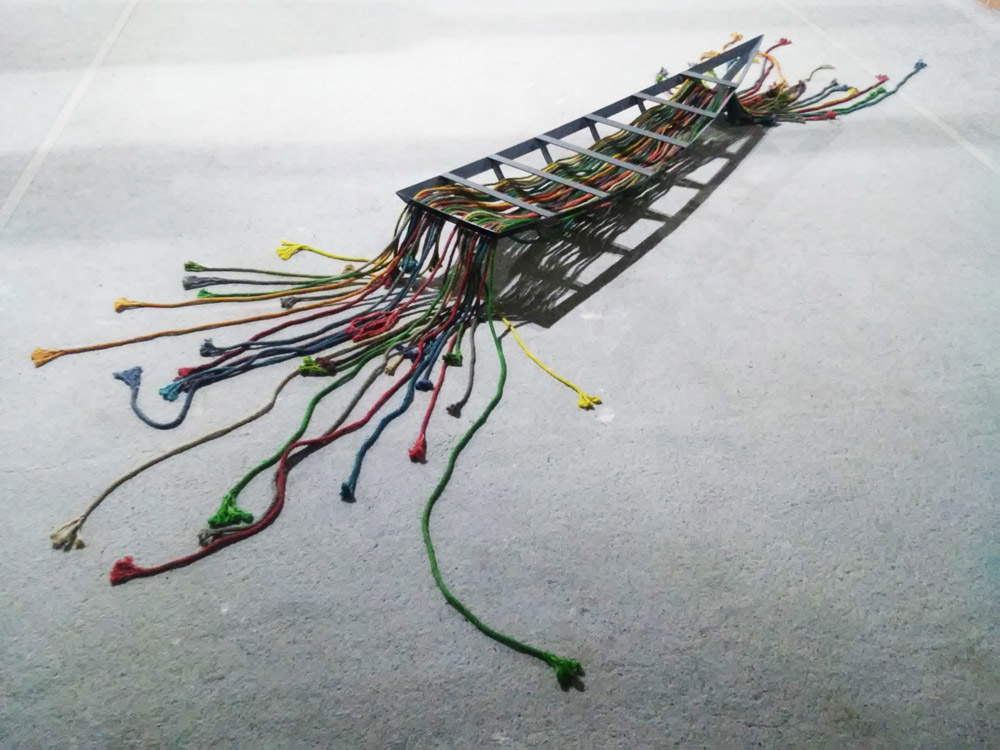 |
| Aurore Pornin, Le grand voyage (2014; iron, rope, colors, 30 x 400 x 130 cm) |
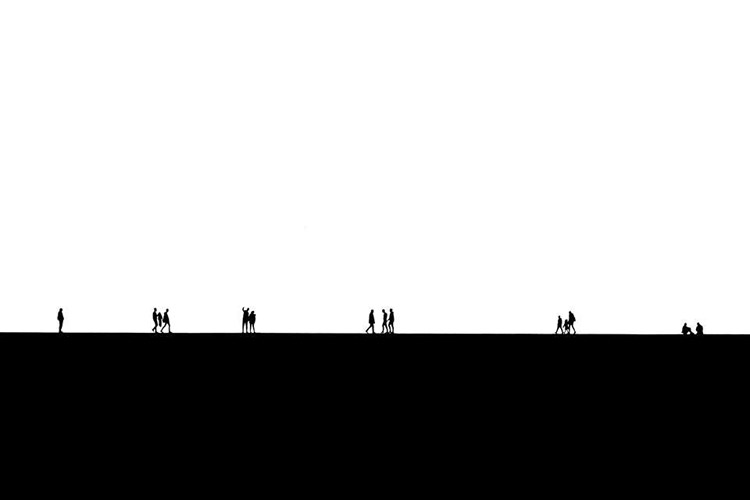 |
| Stefano Siani, Walk on the wall, detail (2017; six photographs on forex, each 20 x 53 cm) |
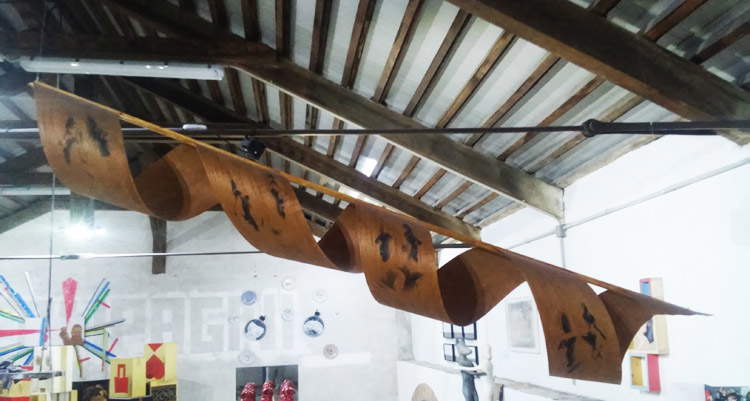 |
| Simone Conti, Pathway (2017; photographs on wood, 200 x 40 cm) |
And of many of these encounters, all that remains is the memory: a theme that meanders throughout the entire exhibition is that of memory, which, again quoting the curator, “with the passage of time modifies, changes, and leaves behind and hidden parts of what was there.” On the recovery of memory, Roberta Montaruli’s work, Ricordo di classe, intervenes on a first level, focusing on the traces that memories and memory leave behind. An eighth-grade photograph sees its protagonists disappear and take on the appearance of a hazy shadow shrouding the remains of a bench. Roberta Montaruli also appeals to the emotions of the observer, who feels involved in the foreground: the mind races to the memories of classmates from that time, to those who still hang out, to those with whom contact has been lost, to those who are no longer with us, trying to focus on moments, situations, affections of a time long gone. At a higher level, that is, on the level of a historical memory, is the installation by Melissa Mariotti, who with Divenire works on a letter by the anarchist Gino Lucetti, who made an attempt on Mussolini’s life and for that reason was sentenced to thirty years in prison. The letter, with a process that recalls Lettrism and in the final result resembles the compositions of Vincenzo Accame, is gradually reduced to its essence: graphemes that mark the sheet revealing the harshness of the author’s personality, his impulses, his aspirations. Next to the letter, Melissa Mariotti places a 3D print with the profile of the Apuan Alps: the letter, from prison, returns to the site where the antifascism of Lucetti and his comrades burned vividly and purely, to that strip of land squeezed between the sea and the mountains that became one of the symbolic places of resistance. It is geographical belonging that also becomes political belonging and becomes a warning and spur for future struggles. Many of which are represented by one of the political symbols par excellence, the hammer and sickle that Francesco Ricci shatters and reassembles in his Come un campo di papaveri (Like a field of poppies). The opposition between symbol understood as convention and symbol understood as a powerful evocative image is perhaps resolved in favor of the second meaning: one is reminded of Gombrich, who in his Icones symbolicae had posed the same problem and had come to affirm that “our attitude toward words and images changes all the time,” “it differs according to our level of awareness,” and that “what is rejected by reason may nevertheless be accepted by our emotions.”
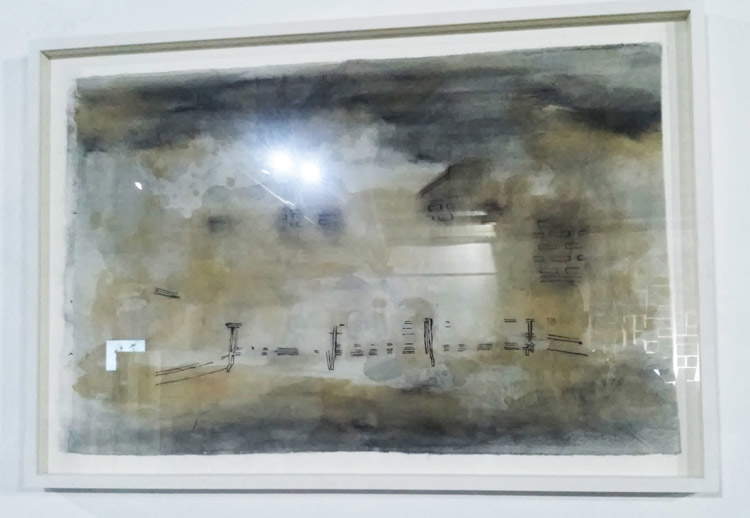 |
| Roberta Montaruli, Memories of Class (2017; mixed media on fabric, 82 x 56 cm) |
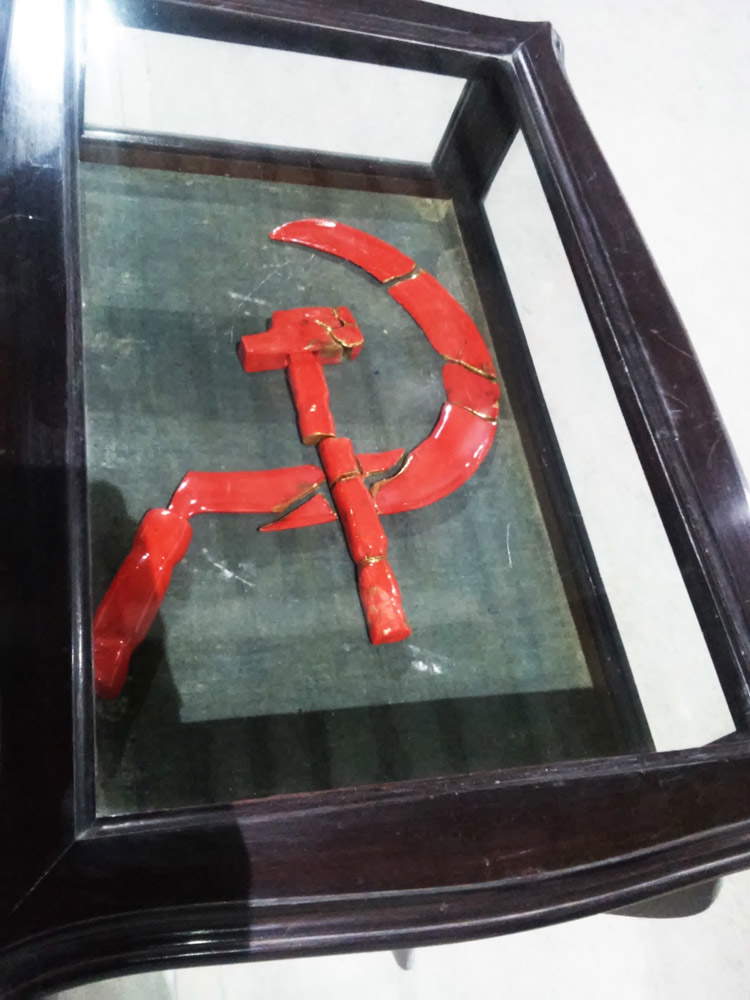 |
| Francesco Ricci, Like a Field of Poppies (2017; glazed ceramic and gold) |
“Emotion” is a term that recurs often in the words of those who visit the exhibition. For there are also works that strike a strong chord. This is the case, for example, of Playground in Aleppo, the work of an experienced artist like Paolo Fiorellini, who from the ceiling of the former Carrara shed hangs the sad swing mentioned in the opening: but there are no children, no space for joy, no lightheartedness. Only emptiness, loneliness and the dust raised by a cruel and senseless war. Emotions are also aroused by the work of Francesco Siani who, above a reflective surface from which the viewer almost never escapes (as if the artist wants to make everyone participate in his idea), arranges a forest of red gloves (or Red Gloves, as per the title of the installation) that form closed fists which, in turn, “are reflected in the infinity of mirrors,” as if to say that struggles have and must never end. It seems to stand out on the back wall the most natural conclusion of the exhibition: Neither God, nor master, the latest work by the always surprising artist Zino, borrows its title from Blanqui’s well-known newspaper, becoming a stance that takes the form of a deflagration of colors, the idea of the individual who recognizes himself in a collective, the force that spurs aspirations to give rise to concrete actions.
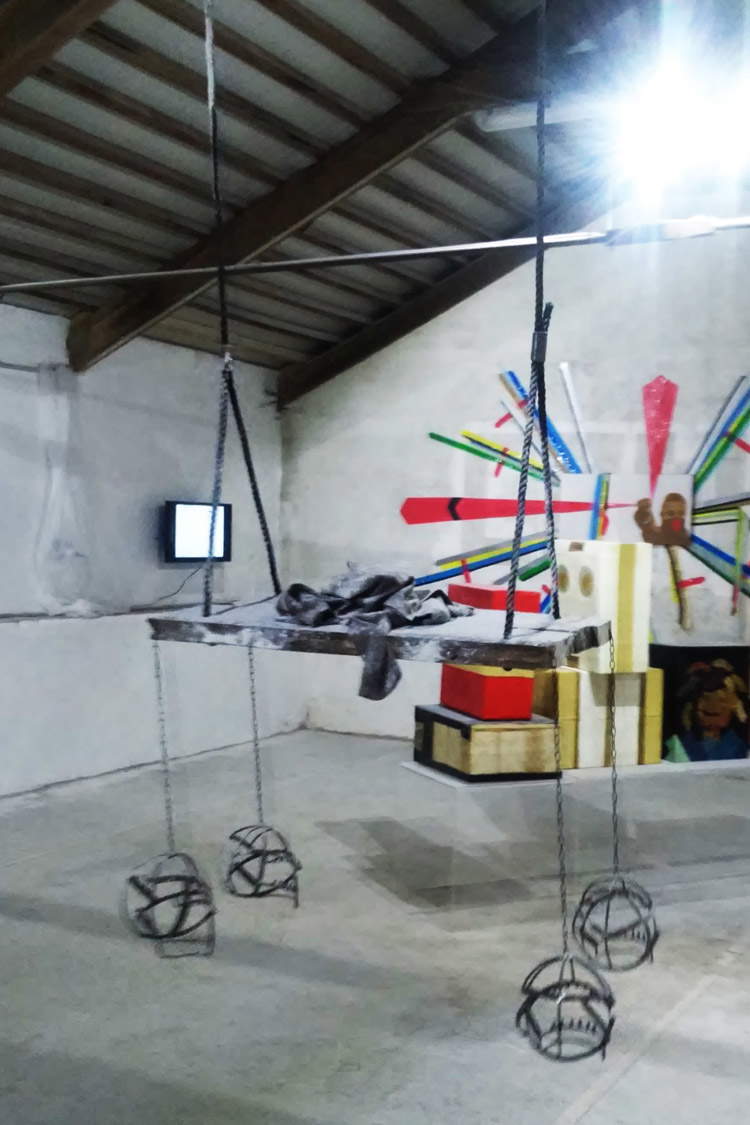 |
| Paolo Fiorellini, Playground in Aleppo (2017) |
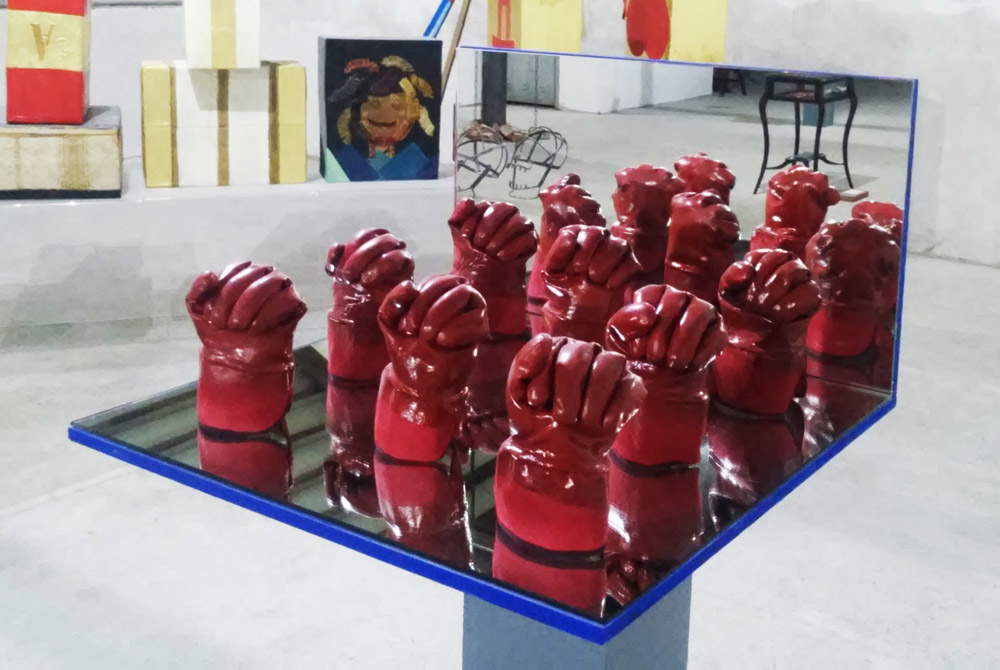 |
| Francesco Siani, Red gloves (2017; rubber, pigments, mirror, 70 x 70 x 40 cm) |
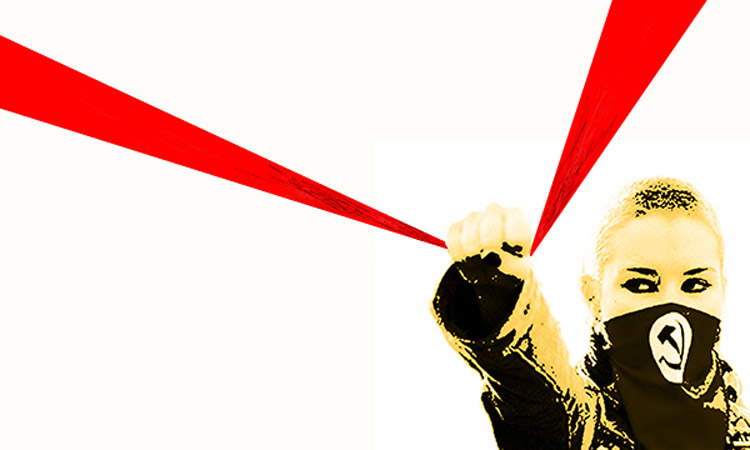 |
| Zino, Neither God nor Master, detail (2017; packing tape on synthetic glass, 100 x 50 cm) |
If Companions. Contemporary Declinations is an exhibition connoted by a strong political component, it is equally true that minimizing it to that meaning would be somewhat reductive for an operation that is placed, with great consistency, in the context of a precise path that the artists in the exhibition (albeit with the natural additions and defections that being in a group necessarily entails) have been pursuing for some time now and that intends to propose to the public a broader vision of what it means to be comrades in a society where the spaces for conviviality seem to be increasingly reduced. In this sense,art, as the artists of Comrades want to demonstrate, is both a tool for allowing thoughts, reflections, expectations and hopes to flow freely, as well as a method, in the etymological sense of the term, for traveling the paths of both memory and the present, and an invitation to action.
Warning: the translation into English of the original Italian article was created using automatic tools. We undertake to review all articles, but we do not guarantee the total absence of inaccuracies in the translation due to the program. You can find the original by clicking on the ITA button. If you find any mistake,please contact us.